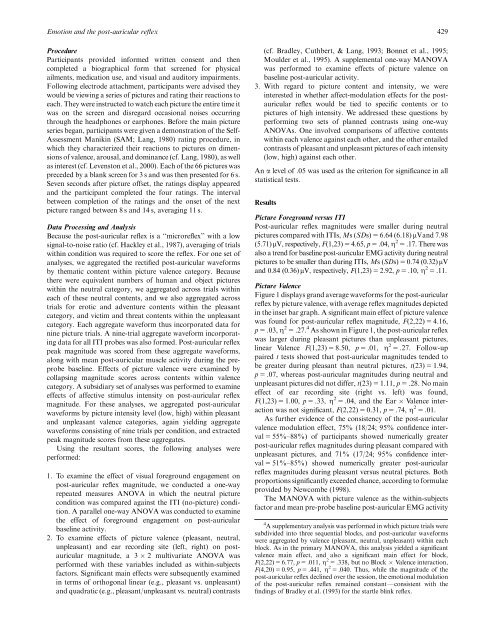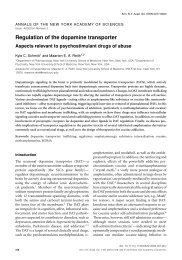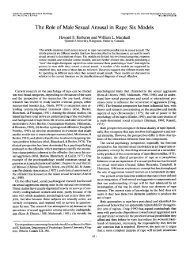Emotional modulation of the postauricular reflex
Emotional modulation of the postauricular reflex
Emotional modulation of the postauricular reflex
You also want an ePaper? Increase the reach of your titles
YUMPU automatically turns print PDFs into web optimized ePapers that Google loves.
Emotion and <strong>the</strong> post-auricular <strong>reflex</strong> 429<br />
Procedure<br />
Participants provided informed written consent and <strong>the</strong>n<br />
completed a biographical form that screened for physical<br />
ailments, medication use, and visual and auditory impairments.<br />
Following electrode attachment, participants were advised <strong>the</strong>y<br />
would be viewing a series <strong>of</strong> pictures and rating <strong>the</strong>ir reactions to<br />
each. They were instructed to watch each picture <strong>the</strong> entire time it<br />
was on <strong>the</strong> screen and disregard occasional noises occurring<br />
through <strong>the</strong> headphones or earphones. Before <strong>the</strong> main picture<br />
series began, participants were given a demonstration <strong>of</strong> <strong>the</strong> Self-<br />
Assessment Manikin (SAM; Lang, 1980) rating procedure, in<br />
which <strong>the</strong>y characterized <strong>the</strong>ir reactions to pictures on dimensions<br />
<strong>of</strong> valence, arousal, and dominance (cf. Lang, 1980), as well<br />
as interest (cf. Levenston et al., 2000). Each <strong>of</strong> <strong>the</strong> 66 pictures was<br />
preceded by a blank screen for 3 s and was <strong>the</strong>n presented for 6 s.<br />
Seven seconds after picture <strong>of</strong>fset, <strong>the</strong> ratings display appeared<br />
and <strong>the</strong> participant completed <strong>the</strong> four ratings. The interval<br />
between completion <strong>of</strong> <strong>the</strong> ratings and <strong>the</strong> onset <strong>of</strong> <strong>the</strong> next<br />
picture ranged between 8 s and 14 s, averaging 11 s.<br />
Data Processing and Analysis<br />
Because <strong>the</strong> post-auricular <strong>reflex</strong> is a ‘‘micro<strong>reflex</strong>’’ with a low<br />
signal-to-noise ratio (cf. Hackley et al., 1987), averaging <strong>of</strong> trials<br />
within condition was required to score <strong>the</strong> <strong>reflex</strong>. For one set <strong>of</strong><br />
analyses, we aggregated <strong>the</strong> rectified post-auricular waveforms<br />
by <strong>the</strong>matic content within picture valence category. Because<br />
<strong>the</strong>re were equivalent numbers <strong>of</strong> human and object pictures<br />
within <strong>the</strong> neutral category, we aggregated across trials within<br />
each <strong>of</strong> <strong>the</strong>se neutral contents, and we also aggregated across<br />
trials for erotic and adventure contents within <strong>the</strong> pleasant<br />
category, and victim and threat contents within <strong>the</strong> unpleasant<br />
category. Each aggregate waveform thus incorporated data for<br />
nine picture trials. A nine-trial aggregate waveform incorporating<br />
data for all ITI probes was also formed. Post-auricular <strong>reflex</strong><br />
peak magnitude was scored from <strong>the</strong>se aggregate waveforms,<br />
along with mean post-auricular muscle activity during <strong>the</strong> preprobe<br />
baseline. Effects <strong>of</strong> picture valence were examined by<br />
collapsing magnitude scores across contents within valence<br />
category. A subsidiary set <strong>of</strong> analyses was performed to examine<br />
effects <strong>of</strong> affective stimulus intensity on post-auricular <strong>reflex</strong><br />
magnitude. For <strong>the</strong>se analyses, we aggregated post-auricular<br />
waveforms by picture intensity level (low, high) within pleasant<br />
and unpleasant valence categories, again yielding aggregate<br />
waveforms consisting <strong>of</strong> nine trials per condition, and extracted<br />
peak magnitude scores from <strong>the</strong>se aggregates.<br />
Using <strong>the</strong> resultant scores, <strong>the</strong> following analyses were<br />
performed:<br />
1. To examine <strong>the</strong> effect <strong>of</strong> visual foreground engagement on<br />
post-auricular <strong>reflex</strong> magnitude, we conducted a one-way<br />
repeated measures ANOVA in which <strong>the</strong> neutral picture<br />
condition was compared against <strong>the</strong> ITI (no-picture) condition.<br />
A parallel one-way ANOVA was conducted to examine<br />
<strong>the</strong> effect <strong>of</strong> foreground engagement on post-auricular<br />
baseline activity.<br />
2. To examine effects <strong>of</strong> picture valence (pleasant, neutral,<br />
unpleasant) and ear recording site (left, right) on <strong>postauricular</strong><br />
magnitude, a 3 2 multivariate ANOVA was<br />
performed with <strong>the</strong>se variables included as within-subjects<br />
factors. Significant main effects were subsequently examined<br />
in terms <strong>of</strong> orthogonal linear (e.g., pleasant vs. unpleasant)<br />
and quadratic (e.g., pleasant/unpleasant vs. neutral) contrasts<br />
(cf. Bradley, Cuthbert, & Lang, 1993; Bonnet et al., 1995;<br />
Moulder et al., 1995). A supplemental one-way MANOVA<br />
was performed to examine effects <strong>of</strong> picture valence on<br />
baseline post-auricular activity.<br />
3. With regard to picture content and intensity, we were<br />
interested in whe<strong>the</strong>r affect-<strong>modulation</strong> effects for <strong>the</strong> <strong>postauricular</strong><br />
<strong>reflex</strong> would be tied to specific contents or to<br />
pictures <strong>of</strong> high intensity. We addressed <strong>the</strong>se questions by<br />
performing two sets <strong>of</strong> planned contrasts using one-way<br />
ANOVAs. One involved comparisons <strong>of</strong> affective contents<br />
within each valence against each o<strong>the</strong>r, and <strong>the</strong> o<strong>the</strong>r entailed<br />
contrasts <strong>of</strong> pleasant and unpleasant pictures <strong>of</strong> each intensity<br />
(low, high) against each o<strong>the</strong>r.<br />
An a level <strong>of</strong> .05 was used as <strong>the</strong> criterion for significance in all<br />
statistical tests.<br />
Results<br />
Picture Foreground versus ITI<br />
Post-auricular <strong>reflex</strong> magnitudes were smaller during neutral<br />
pictures compared with ITIs, Ms(SDs) 5 6.64 (6.18) mVand 7.98<br />
(5.71) mV, respectively, F(1,23) 5 4.65, p 5 .04, Z 2 5 .17. There was<br />
also a trend for baseline post-auricular EMG activity during neutral<br />
pictures to be smaller than during ITIs, Ms(SDs) 5 0.74 (0.32) mV<br />
and 0.84 (0.36) mV, respectively, F(1,23) 5 2.92, p 5 .10, Z 2 5 .11.<br />
Picture Valence<br />
Figure 1 displays grand average waveforms for <strong>the</strong> post-auricular<br />
<strong>reflex</strong> by picture valence, with average <strong>reflex</strong> magnitudes depicted<br />
in <strong>the</strong> inset bar graph. A significant main effect <strong>of</strong> picture valence<br />
was found for post-auricular <strong>reflex</strong> magnitude, F(2,22) 5 4.16,<br />
p 5 .03, Z 2 5 .27. 4 As shown in Figure 1, <strong>the</strong> post-auricular <strong>reflex</strong><br />
was larger during pleasant pictures than unpleasant pictures,<br />
linear Valence F(1,23) 5 8.50, p 5 .01, Z 2 5 .27. Follow-up<br />
paired t tests showed that post-auricular magnitudes tended to<br />
be greater during pleasant than neutral pictures, t(23) 5 1.94,<br />
p 5 .07, whereas post-auricular magnitudes during neutral and<br />
unpleasant pictures did not differ, t(23) 5 1.11, p 5 .28. No main<br />
effect <strong>of</strong> ear recording site (right vs. left) was found,<br />
F(1,23) 5 1.00, p 5 .33, Z 2 5 .04, and <strong>the</strong> Ear Valence interaction<br />
was not significant, F(2,22) 5 0.31, p 5 .74, Z 2 5 .01.<br />
As fur<strong>the</strong>r evidence <strong>of</strong> <strong>the</strong> consistency <strong>of</strong> <strong>the</strong> post-auricular<br />
valence <strong>modulation</strong> effect, 75% (18/24; 95% confidence interval<br />
5 55%–88%) <strong>of</strong> participants showed numerically greater<br />
post-auricular <strong>reflex</strong> magnitudes during pleasant compared with<br />
unpleasant pictures, and 71% (17/24; 95% confidence interval<br />
5 51%–85%) showed numerically greater post-auricular<br />
<strong>reflex</strong> magnitudes during pleasant versus neutral pictures. Both<br />
proportions significantly exceeded chance, according to formulae<br />
provided by Newcombe (1998).<br />
The MANOVA with picture valence as <strong>the</strong> within-subjects<br />
factor and mean pre-probe baseline post-auricular EMG activity<br />
4 A supplementary analysis was performed in which picture trials were<br />
subdivided into three sequential blocks, and post-auricular waveforms<br />
were aggregated by valence (pleasant, neutral, unpleasant) within each<br />
block. As in <strong>the</strong> primary MANOVA, this analysis yielded a significant<br />
valence main effect, and also a significant main effect for block,<br />
F(2,22) 5 6.77, p 5 .011, Z 2 5 .338, but no Block Valence interaction,<br />
F(4,20) 5 0.95, p 5 .441, Z 2 5 .040. Thus, while <strong>the</strong> magnitude <strong>of</strong> <strong>the</strong><br />
post-auricular <strong>reflex</strong> declined over <strong>the</strong> session, <strong>the</strong> emotional <strong>modulation</strong><br />
<strong>of</strong> <strong>the</strong> post-auricular <strong>reflex</strong> remained constantFconsistent with <strong>the</strong><br />
findings <strong>of</strong> Bradley et al. (1993) for <strong>the</strong> startle blink <strong>reflex</strong>.










